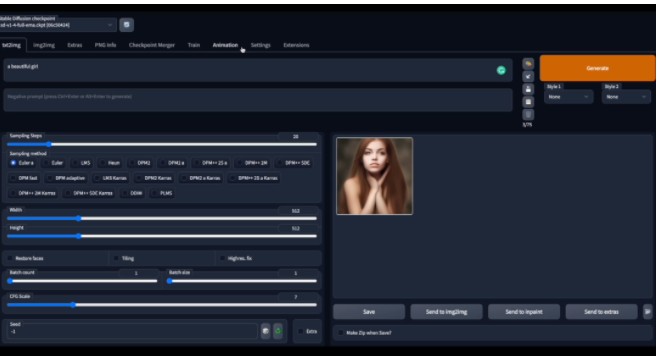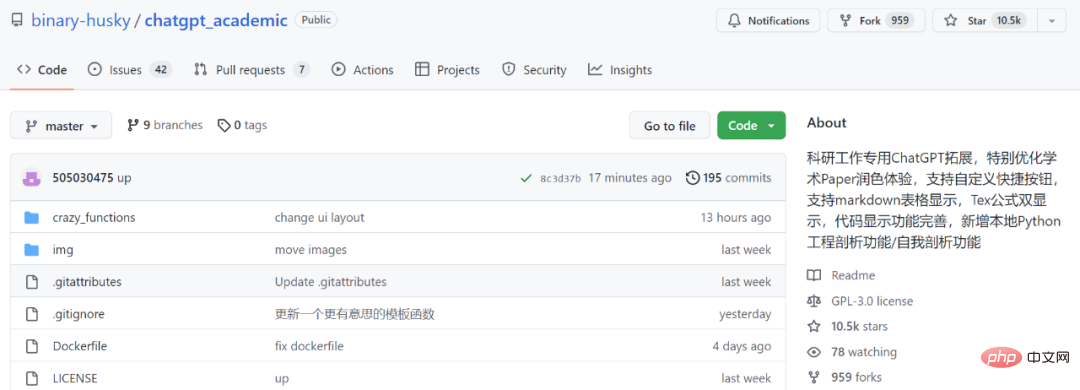 Technology peripherals
Technology peripherals AI
AI CIO shares: Enterprise IT should use generative AI with caution moving forward
CIO shares: Enterprise IT should use generative AI with caution moving forward
Vince Kellen is the Chief Information Officer of the University of California, San Diego (UCSD) and is familiar with ChatGPT, DALL-E and other generative AI The technology has well-documented limitations: the answers generated may not be realistic, the images generated may lack integrity, and the output may be biased. But he's moving forward anyway, saying employees are already using ChatGPT to write code and job descriptions.
OpenAI’s text generation technology ChatGPT and image generation technology DALL-E are the most prominent among a series of large-scale language models (also called generative language models or generative AI) that have captured the public imagination. Models respond to written requests to generate answers ranging from text documents and images to programming code.
Kellen believes that the code generated by ChatGPT is a productivity tool, just like the compiler is an improvement on assembly language. “Generating things for libraries and software is no different than searching GitHub,” he said, “and we also use it to write job descriptions that are content and format-sensitive. You can then move on to editing very quickly, looking for errors and areas of confusion. "While this technology is still in its early stages, there's no denying the impact it's already having on certain enterprise applications, such as those that are content and workflow intensive, but you'll want to proceed with caution.
Ready for the right applications
Oliver Wittmaier, chief information officer and product lead at DB SYSTEL, said generative AI is ready for coding, managing workflows, data Refined and simple use cases (e.g. pre-filled forms), DB SYSTEL is a wholly owned subsidiary of DB AG and digital partner for all group companies. In the transportation industry, he said, "artificial intelligence can directly or indirectly affect congestion avoidance, steering and management of transportation processes."
Content generation is also of particular interest to Michal Cenkl, director of innovation and experiments at Miter field. Currently, his team is investigating two uses for the technology, in the intellectual and professional fields. “The first is if I want to write an email to one of our sponsors summarizing the work we do and the work relevant to them, and that’s in the context of the communications we’ve had with them Email. This technology is incredibly powerful."
The second is project staffing. Typically, Cenkl will review resumes and search based on skill tags to find candidates who match the project. Generative AI can help do this. "For example, I might want to ask, 'What can Michael do on this project?' and summarize what he can do based on what he is doing now, so that I don't need to search through the resume."
Used car retailer CarMax has been using generative AI for more than a year, leveraging OpenAI’s API to consolidate customer review text into summaries that are more manageable and readable. But Shamim Mohammad, the company's chief information officer, said his team has applied the technology to other areas as well.
Among them, vehicle imaging can help improve customer experience. He said the AI can optimize images of every vehicle they add to their inventory, which ranges from 50,000 to 60,000 vehicles at any given time. “We make every image as realistic as possible without sacrificing effectiveness.” For example, their data scientists created a “digital sweeper” model that uses an image showing a car parked on a clean floor. , replacing a photo of a car parked on a dirty floor. "It's still the same car, but the photos look better, which is a better experience for customers." Similarly, Forrester analyst Rowan Curran said that Nike has been using generative AI to generate product prototype images. "You can use the text-to-3D modeler to test it in 3D space and get a more intuitive idea of how it will look in the real world — all with ease," he said. Applications with the greatest potential returns
Creating code and improving customer experiences are the main areas where businesses are using generative AI today, with the greatest potential returns in terms of increased efficiency, Mohammad said.
Gary Jeter, executive vice president and chief information officer of TruStone Financial Credit Union, said that this is exactly what his developers hope to do by implementing the OpenAI Codex on GitHub. Moreover, coding with generative AI works very well. Generative AI models work better at coding than human language because programming languages are more structured, Cenkl said. "It teases out that structure, so it works better."
CarMax is testing GitHub's Copilot, and he says engineers may be generating up to 40% less code in some cases. “Evolution moves very quickly, but if you use it to create software, you have to make sure you’re not infringing copyright, generating false content, or embedding malware. You can’t insert this code without supervision.
Curran said other areas are ripe for enterprise applications, such as generating marketing copy, graphics, design, and creating better summaries of data so people can use the data more effectively. “Some people are even using these large language models to clean unstructured data,” he said. Next, he said, generative AI capabilities may start to appear in some enterprise software, such as technical support software and Microsoft Office applications.
Don’t trust easily, verify first
CarMax’s Mohammad warns that in addition to the benefits, CIOs deploying this technology will also need to understand the issues surrounding the content output generated. Potential intellectual property issues. Generative models, such as DALL-E, which is trained on internet data, can generate content that may infringe copyright, which is why Getty Images recently sued Stability AI over its AI-powered art generation tool Stable Diffusion.
This technology also requires human supervision. “Systems like ChatGPT don’t know what they’re creating, and these systems are very good at making you believe that what they’re saying is accurate, even if it’s not,” Cenkl said. No AI can guarantee that — no attributes or Reference information lets you know how it arrived at a response, and there is no AI interpretability that shows why something is written the way it is. “You don’t know what the underlying basis is, you don’t know what parts of the training set are influencing the model, and what you get is purely an analysis based on the existing data set, so you not only have the potential for bias, but also for de facto Wrong."
Wittmaier is bullish on the technology but still believes it is an early technology that could be used for customer-facing deployments. At this point, he said, office suite environments, customer contact chatbots, technical support functions and general documentation all have short-term potential, but when it comes to safety-related areas of a transportation company's business, the answer is clearly no. He said: "We still have a lot to learn and improve before we can incorporate generative AI into these sensitive areas."
Jeter has similar concerns. While his team used ChatGPT to identify code fixes and deploy them to the site in 30 minutes, "without ChatGPT it would have taken much longer," and he believes ChatGPT is also useful for drafting contract terms and conditions. , but these have not yet been fully verified. "We will not expose any generative AI to outside members, and TruStone will not be at the forefront in this area."
When TruStone finally starts using the technology to bring benefits to its members, he added , conversations will be monitored through human and automated review to protect members and the brand.
Today, the key to successful deployments remains having humans in the loop to review the generated content for accuracy and compliance, said Kellen of the University of California, San Diego. "Ensuring that machines make the right decisions will be a significant litigation point, and it will be a long time before organizations use the technology to do anything high-risk - such as medical diagnostics. But generative AI can be very It's good to generate things like review summaries, assuming there's human supervision. This slows us down a bit, but it's the right thing to do. Eventually, we'll find automated ways to ensure quality. But for now, you have to have A review process to ensure the content generated is accurate.”
In addition to accuracy, another well-documented risk is the potential for bias in models brought in from the training data center. Kellen says this is especially problematic when generative AI uses content from the internet — as ChatGPT does. But when you train the model on your own private company's data, you can check for potential bias and this may not be an issue. He said: "The deeper you go into the enterprise, and the more restricted and common the data categories there are, the more useful generative AI will be."
The thing you need to know about large language models, Cenkl said, is that these Machines are experts to a certain extent. "They don't understand, but they are very good at computing."
Changes in job responsibilities and roles
"Technology can make things better, but it also brings us a lot of extra work.” However, he thinks generative AI is different. "This is exciting because it takes away some of the things we don't like to do and makes us smarter, and it makes humans stronger."
But Curran pointed out that generative AI will not completely replace any role in the short term. “It might reduce the number of people needed to perform a role, such as content development, product information management, or software development, but there will always be humans involved,” he said. Mohammad added that generative AI technology can write And to summarize, human intelligence is always needed to ensure content quality and control the generated content to make it better.
Get started
Kellen said now is the time to accelerate generative AI technology and start experimenting. He said: "CIOs must solve this problem before they are confused by vendors who embed technology into their enterprise software products. If you continue to delay next year, you will be behind the curve."
Curran said it is important to understand the technology and explore it in depth rather than creating a public buzz around ChatGPT, to understand that the technology is much more complex than its application. Then start thinking about the possible uses of generative AI to improve the efficiency or quality of existing processes. Finally, ask yourself what type of functionality you need and whether you will get it from a vendor or build it yourself.
The next step is to test the technology and consider potential use cases. "A lot of your systems, whether they're using structured or unstructured data, are going to have at least some components of natural language and conversational interfaces," Cenkl said. "Think about the data you have and think about the technologies that can enhance it. which parts of it,” and then demonstrate its potential. For example, Jeter said he generated a terms and conditions template and sent it to compliance departments to show how they were using the technology.
Generative AI models are large and training them from scratch is extremely expensive, so the best way to get started is to use one of the cloud services, Curran said. For example, CarMax uses Microsoft Azure OpenAI service with GPT 3.5. “The data we load is our own – it’s not shared with others, and we can have large amounts of data and quickly process it to run our models,” Mohammad said. “This might be useful if you have a small team or a business problem. If you want to learn generative AI technology, give it a try.”
The above is the detailed content of CIO shares: Enterprise IT should use generative AI with caution moving forward. For more information, please follow other related articles on the PHP Chinese website!
 令人惊艳的4个ChatGPT项目,开源了!Mar 30, 2023 pm 02:11 PM
令人惊艳的4个ChatGPT项目,开源了!Mar 30, 2023 pm 02:11 PM自从 ChatGPT、Stable Diffusion 发布以来,各种相关开源项目百花齐放,着实让人应接不暇。今天,着重挑选几个优质的开源项目分享给大家,对我们的日常工作、学习生活,都会有很大的帮助。
 Word文档拆分后的子文档字体格式变了怎么办Feb 07, 2023 am 11:40 AM
Word文档拆分后的子文档字体格式变了怎么办Feb 07, 2023 am 11:40 AMWord文档拆分后的子文档字体格式变了的解决办法:1、在大纲模式拆分文档前,先选中正文内容创建一个新的样式,给样式取一个与众不同的名字;2、选中第二段正文内容,通过选择相似文本的功能将剩余正文内容全部设置为新建样式格式;3、进入大纲模式进行文档拆分,操作完成后打开子文档,正文字体格式就是拆分前新建的样式内容。
 vscode配置中文插件,带你无需注册体验ChatGPT!Dec 16, 2022 pm 07:51 PM
vscode配置中文插件,带你无需注册体验ChatGPT!Dec 16, 2022 pm 07:51 PM面对一夜爆火的 ChatGPT ,我最终也没抵得住诱惑,决定体验一下,不过这玩意要注册需要外国手机号以及科学上网,将许多人拦在门外,本篇博客将体验当下爆火的 ChatGPT 以及无需注册和科学上网,拿来即用的 ChatGPT 使用攻略,快来试试吧!
 学术专用版ChatGPT火了,一键完成论文润色、代码解释、报告生成Apr 04, 2023 pm 01:05 PM
学术专用版ChatGPT火了,一键完成论文润色、代码解释、报告生成Apr 04, 2023 pm 01:05 PM用 ChatGPT 辅助写论文这件事,越来越靠谱了。 ChatGPT 发布以来,各个领域的从业者都在探索 ChatGPT 的应用前景,挖掘它的潜力。其中,学术文本的理解与编辑是一种极具挑战性的应用场景,因为学术文本需要较高的专业性、严谨性等,有时还需要处理公式、代码、图谱等特殊的内容格式。现在,一个名为「ChatGPT 学术优化(chatgpt_academic)」的新项目在 GitHub 上爆火,上线几天就在 GitHub 上狂揽上万 Star。项目地址:https://github.com/
 30行Python代码就可以调用ChatGPT API总结论文的主要内容Apr 04, 2023 pm 12:05 PM
30行Python代码就可以调用ChatGPT API总结论文的主要内容Apr 04, 2023 pm 12:05 PM阅读论文可以说是我们的日常工作之一,论文的数量太多,我们如何快速阅读归纳呢?自从ChatGPT出现以后,有很多阅读论文的服务可以使用。其实使用ChatGPT API非常简单,我们只用30行python代码就可以在本地搭建一个自己的应用。 阅读论文可以说是我们的日常工作之一,论文的数量太多,我们如何快速阅读归纳呢?自从ChatGPT出现以后,有很多阅读论文的服务可以使用。其实使用ChatGPT API非常简单,我们只用30行python代码就可以在本地搭建一个自己的应用。使用 Python 和 C
 用ChatGPT秒建大模型!OpenAI全新插件杀疯了,接入代码解释器一键getApr 04, 2023 am 11:30 AM
用ChatGPT秒建大模型!OpenAI全新插件杀疯了,接入代码解释器一键getApr 04, 2023 am 11:30 AMChatGPT可以联网后,OpenAI还火速介绍了一款代码生成器,在这个插件的加持下,ChatGPT甚至可以自己生成机器学习模型了。 上周五,OpenAI刚刚宣布了惊爆的消息,ChatGPT可以联网,接入第三方插件了!而除了第三方插件,OpenAI也介绍了一款自家的插件「代码解释器」,并给出了几个特别的用例:解决定量和定性的数学问题;进行数据分析和可视化;快速转换文件格式。此外,Greg Brockman演示了ChatGPT还可以对上传视频文件进行处理。而一位叫Andrew Mayne的畅销作
 ChatGPT教我学习PHP中AOP的实现(附代码)Mar 30, 2023 am 10:45 AM
ChatGPT教我学习PHP中AOP的实现(附代码)Mar 30, 2023 am 10:45 AM本篇文章给大家带来了关于php的相关知识,其中主要介绍了我是怎么用ChatGPT学习PHP中AOP的实现,感兴趣的朋友下面一起来看一下吧,希望对大家有帮助。


Hot AI Tools

Undresser.AI Undress
AI-powered app for creating realistic nude photos

AI Clothes Remover
Online AI tool for removing clothes from photos.

Undress AI Tool
Undress images for free

Clothoff.io
AI clothes remover

AI Hentai Generator
Generate AI Hentai for free.

Hot Article

Hot Tools

SAP NetWeaver Server Adapter for Eclipse
Integrate Eclipse with SAP NetWeaver application server.

Dreamweaver Mac version
Visual web development tools

ZendStudio 13.5.1 Mac
Powerful PHP integrated development environment

Atom editor mac version download
The most popular open source editor

SublimeText3 Linux new version
SublimeText3 Linux latest version







